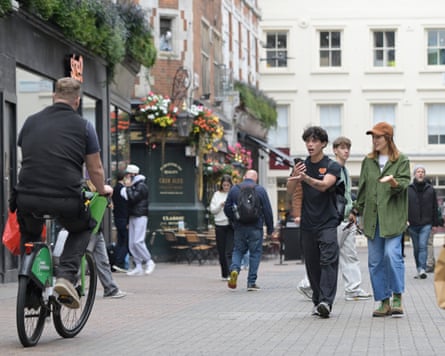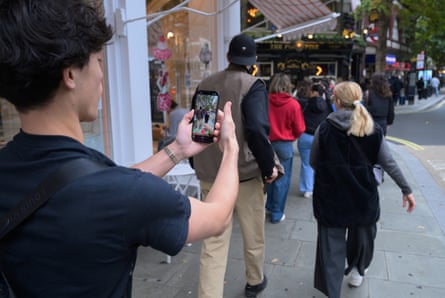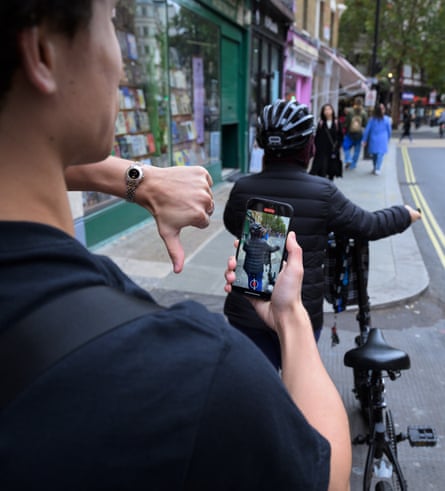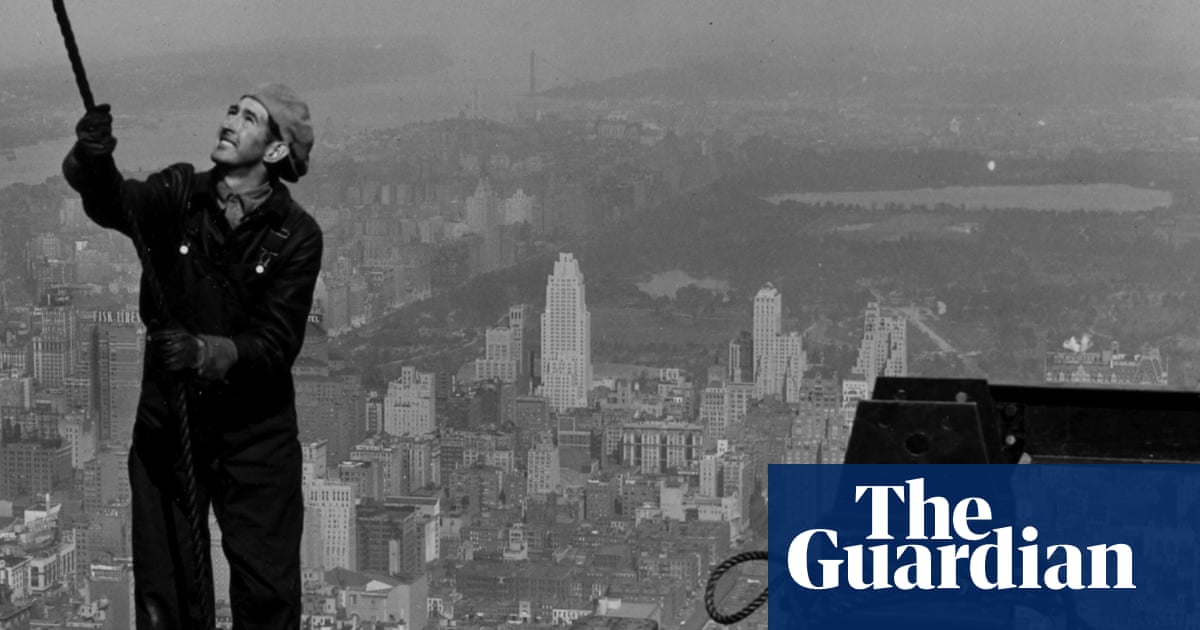It’s a damp, grey morning in Soho, London, and Cameron Roh is standing a metre or so behind a woman who is speaking loudly into her phone outside Caffè Nero. She is breaking his “laws” of “pavement etiquette” and he holds up his phone and presses record. Lost in conversation, the woman doesn’t see him, but still, watching him from a distance, it’s fist-in-mouth awkward. What if she turns around? Is this allowed? Is this even OK?
Suddenly, the woman hangs up and dashes across the road, oblivious to what has just happened. Evidence duly captured, Roh returns to where I am hiding and delivers his verdict, which is marks out of 10 – with 10 being perfect pavement etiquette. “That’s a two,” he says. Her crimes? “On her phone, sudden stop, pretty much in the centre of the pavement, meaning people have to walk around her to get past. No, no, no.” She didn’t see us, but that somehow feels worse; I feel as if we’ve just pickpocketed her. Roh giggles, unfazed. As a self-appointed pavement vigilante, this is what he does.
The first video 21-year-old Roh posted was in July. In about 20 seconds, he follows five different walkers, quietly unpacking their gait to camera before rating them for speed, direction, footwork and phone use. He has since rated walkers in New York in more than 30 videos, and has recently diversified to other US cities. This is his first time in the specific chaos of central London. “So far, it seems comparable to New York,” he says. Just then, a Lime bike almost collides with us outside a cinema. “Come on!” he cries. “Those city bikes are a new thing. That’s an automatic zero, buddy.”
Roh says he tries to make sure that nobody is identifiable in his videos and he has strict rules about people who are off limits for criticism. Young children, groups of children, the less able, elderly people – although how he determines whether someone is less able is unclear. At one point, we watch a small woman, who I would guess is in her early 60s, pushing a Brompton bike, navigating her way through a school group while on her phone. Roh watches her and decides against filming, even though she is breaking almost every one of his rules. “I focus on people who actively choose to be inconsiderate,” he says. And it’s not just because they bother other pavement users, he says. “They are also safety hazards.” The woman with the Brompton is “fast, and clearly has somewhere to be”.
Rather than presume there is a right way to walk, Roh is proposing that everyone simply has the right to walk. Yet whether it’s manspreading on buses or queue-jumping, frustration at poor public protocol is not only common, it’s a bedrock of British humour. That said, while holding strong opinions on how things ought to be done is a very British pastime, getting angry about it in public is not our style. “Rage only ever applies to traffic – it’s the same in New York,” says Roh. “The thing is, no one screams at anyone for walking badly, but we all feel it.”

Pavement etiquette is “getting worse,” he says, in part due to smartphones. He pauses to point out how many people around us are walking while staring at their phones. “I call these people neck breakers,” he says. “People stuck at a 45 degree angle on their phones, not with us in reality”.
When judging walkers, the first thing Roh looks at is speed. “If you’re walking badly – so not in a straight line, or dragging something – but your pace is adequate, then you’re probably not affecting my journey,” he says. Then it’s placement. “If you’re zigzagging, aimlessly cutting people off, not paying attention to your surroundings, that’ll lose you a few points automatically.” Within these, there are some subcategories that will feel both new and familiar – Lime bikes mounting pavements, phone-gawping, scooters on pavements, chuggers, wheelie suitcases that are small enough to be carried, people who are too busy eating on the go to look where they are going. Then there are the head-on walkers who crash into you, he says, as we step aside to avoid one. “If you’re checking your maps, then just pull over,” he mutters to a group of women prodding a screen with their fingers.
Roh has a glossary of misdemeanours that provides the framework for his system. The woman outside Caffè Nero committed the “brake check”, he says, which is when people come to a sudden halt. “Woompf! Hard stop. Right in front of you, no checking the blind spot.”
A personal bugbear is people walking side by side: “double wides” or “triple wides”, and “linked double wides”, which is a couple attached to one another somehow “making it harder to, you know, get through”, he says. What’s the biggest phalanx he’s seen? “Sometimes you get a linked quadruple-wide, at which point …” With a heavy sigh, he shakes his head.
Of course, Roh is not the first person to get in a flap about this stuff. It’s a genre if not invented then normalised by the comic writer Fran Lebowitz, whose cutting maxims about how people should behave in public have been the basis of books and world tours. Roh shrugs when I mention her name and makes a note to Google her later.

We walk round a group of men huddled in the middle of the pavement. They should “leave space for those of us who have somewhere to be”, he mutters. But it goes deeper than that – one of Roh’s biggest frustrations is that cities seem increasingly designed for vehicles rather than people. Pavements are narrow, and often badly paved compared with the roads beside them. Some pavements even slip into roads and back again, with little warning. Walking in cities is a leveller, but it’s also discombobulating and even dangerous, turning a potentially civilised urban stroll into a hip-bumping, traffic-harried race to the finish. “These places aren’t for people, even though they are.” Really, though, it’s about getting from A to B at speed – or capitalism. As Colson Whitehead wrote in The Colossus of New York: “Everyone thinks they are more deserving, everyone thinks their day has been harder than everyone else’s, and everyone is correct.”
As a member of gen Z, Roh has always “lived and breathed social media”. Born and educated in Ohio, he got a glimpse of his future at high school, when he had to deal with “hallway rage”. People in corridors, people loitering … “I’m gonna be late to my destination because of you? No way, that’s gotta stop,” he says. “I’ve always been a fast walker, always knowing where I’m going.”
After moving to New York for its golden opportunities, he was shocked by the way people moved in this tight urban space, so he joined the throngs who have turned TikTok and Instagram into a lucrative sport, and began to film them.

Given Roh’s reservations about smartphones, the irony that his entire body of work is filmed and parsed through a screen is not lost on him. “The world is so disconnected,” he says. “We’re just consumed by our phones and our AirPods. You think it’s just gen Z and gen Alpha, but it’s everyone now. Age is not even a defining factor. But doing what I do, it’s a way of getting out, an activity, so I’m walking with purpose.”
So far, Roh’s videos have accrued 10m views – and he has inspired copycats, something he puts down to this being about “a universal feeling”. His preferred time for vigilantism is first thing in the morning. “I give a little more grace later in the day,” he says, because people tend to be in less of a rush. The videos are fun and cranky, little acts of civil dissent playing out in real time. A man looms into view in front of us, dragging a suitcase alongside him while also looking at his phone. “He’s doing his best,” says Roh. “He’s fast, but he’s taking up space. Have you heard of manspreading? He’s sort of man-walking.”
According to the Metropolitan police, you do not need a permit to film or photograph in public places, and the people Roh films are mostly unrecognisable and filmed from behind. Still, doesn’t he ever feel bad about what he’s doing? “Not really. The reaction I get is thank you. People think I’m cleaning up the cities.” Like Batman, then. “The thing is, we need more of this – we need more people doing this, and then people will walk better.”
I put to Roh that surely there must be room for loafing. Where is the 19th-century flâneur – whose aimless stroll allowed for observation without participation, described by Edmund White as a “compromise between laziness and activity” – in all this? “The what? No. Like, just go to a park,” he says. The thing is, when you see people wandering aimlessly, slowly, blissfully, ignorantly “it kind of makes you jealous, doesn’t it?” he says.
Later that day, as I’m rushing to pick up my children, my path is blocked by a carefree young couple pottering along. Hearing me puff away, the man reflexively steps aside – but too late, I’m on the road, darting around them. I make a mental note – linked double wide, one out of 10 for the acknowledgment. We’re all pavement vigilantes, really: we just don’t have Roh’s vocabulary.

 3 weeks ago
23
3 weeks ago
23

















































